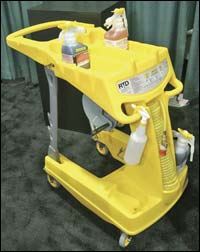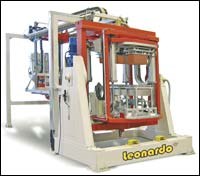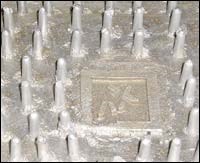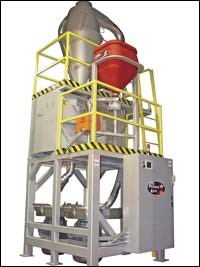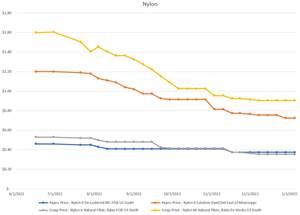Improved Machines and Molds Highlight Fall Rotomolding Show
Worldwide commercial availability of “ovenless” rotomolding machinery, new cast-aluminum molds that provide faster cycles, improved material pulverizing systems, and new graphic transfer systems for engineering materials such as nylon were unveiled at the 30th Annual Fall Meeting of the Association of Rotational Molders (ARM), held in Chicago last fall.
Worldwide commercial availability of “ovenless” rotomolding machinery, new cast-aluminum molds that provide faster cycles, improved material pulverizing systems, and new graphic transfer systems for engineering materials such as nylon were unveiled at the 30th Annual Fall Meeting of the Association of Rotational Molders (ARM), held in Chicago last fall. The show also featured several new shuttle and carousel machines.
Ovenless comes of age
A new “ovenless” rotomolding machine that applies heating and cooling directly to the mold is commercially available worldwide from Persico S.p.A. in Italy. A prototype has been available for use by selected customers since the machine’s introduction in 2003.
The new Leonardo series is said to use less energy and offer more precise temperature control than conventional machines, suiting it to molding engineering materials. The carousel-type, single-station unit uses machined aluminum molds with integral heating and cooling. Electrical resistance wires are installed in the mold for six zones of heating, while a patented internal air-cooling system is also built in. The controls regulate the molding cycle via sensors that measure the mold temperature. The production cycle can also be monitored from a PC. Standard molds can be converted for use on Leonardo.
Ovenless design reduces the machine’s footprint by 25%. Productivity of each mold in this system is said to equal that of four molds on a standard machine due to the close temperature control and automated handling. The carousel arrangement allows for independent operation of different molds running at the same time
Material loading and part loading/unloading are fully automated to reduce labor requirements to a single attendant for start-up. Automation can be configured to place inserts or to charge a mold with two materials for multi-layer products. A single operator can control four to eight machines.
More new machine entries
Powder King, a manufacturer of pulverizing and material-handling equipment, now offers a line of carousel and shuttle rotomolding equipment. The firm recently signed an exclusive agreement with Littleford Plastic International USA, Florence, Ky., to sell Littleford’s new machines in the U.S. and Canada. Littleford manufactures its Spinner series of shuttle machines in five sizes of both straight-arm and offset-arm styles with a swing from 98 to 216 in. Arm capacity ranges from 2970 to 5500 lb for straight-arm designs, and 2200 to 3960 lb for offset arms.
Powder King also offers Littleford’s Carousel series of rotary machines in five sizes with swing-arm diam. from 98 to 177 in. Arm capacity ranges from 2970 to 5060 lb for the straight arm and 2200 to 3520 lb for the offset configuration. Both styles feature Windows-based touchscreen controls.
Sequential production of large and small parts is possible with the new “Double Cart” DC XT shuttle line from Rotoline of Brazil, sold here by Reduction Engineering, Kent, Ohio. The series comes in two models having a cylindrical central oven, two cooling stations, and straight-arm or offset-arm configurations. Two models have oven diam. of 2.5 and 5 meters. The straight arm has a maximum load capacity of 1200 kg (2640 lb) while the offset “C” arm supports up to 700 kg (1540 lb). The arms are driven electrically. Machine operations are controlled with Rotoline’s new DC 1.10 PLC supervisory system.
A new machine supplier in Mexico has introduced a shuttle model. Moviplas bases its machine technology on input from Horacio Lobo Z., a leading rotomolding consultant and cofounder of the Rotoplas company in 1982, and from the CIATEQ R&D center in Queretaro, Mexico.
The system is offered with either a straight arm (67-in. swing diam. and 1100-lb load capacity) or offset arm (64-in.-diam. swing and 1000-lb capacity). The system has natural-gas or propane burners with 1-million BTU capacity (it reaches 700 F), plus a cooling fan and four water-mist nozzles. It also has a touchscreen and Allen-Bradley controls, double overlapped insulation that avoids heat loss, and specially designed gears that bear high mechanical stress and high temperatures.
Molds cycle faster
A new modification for cast-aluminum molds is designed to improve heat transfer from the oven air to the mold. Profit Pins from Norstar Aluminum Molds are pin-shaped projections cast into the outer surface of the mold to transfer heat more rapidly. The 0.5-in.-diam., 2-in.-high pins reduce overall cycle time by 25% to 32%, Norstar claims.
The pins can be added selectively to improve heat flow in hard-to-reach areas of the mold or to draw heat to areas where a thicker buildup of material is desired. Unlike alternative approaches such as heat-shielding parts of the mold, the new pins shorten rather than lengthen cycle times.
Norstar also offers a new venting device that is said to improve part quality. Supavent is a high-temperature flexible silicone vent tube developed by La Plastecnica in New Zealand and distributed by Nor star. Standard PTFE venting tubes are packed with steel wool or other fibrous material to keep material in the mold while allowing gases to escape. But variations in packing density can translate into variable vent flow. This can yield defective parts due to warpage. Rejects can also result from loose packing falling into the part.
Supavent does not use packing material. It allows a small amount of natural pressurization of the mold during heating. Internal mold pressure causes Supavent to perform like a one-way valve that provides free venting as well as faster consolidation of material while eliminating pinholes in parts from trapped gases. The vent tubes are 2.5 in. long and fit in a 0.5-in. hole in the mold. It can handle mold temperatures up to 360 F and is good for 20 to 60 cycles.
More choices in graphics
Two new permanent-label graphics for rotomolded nylon or vinyl parts are available from Mold In Graphics Systems. Its new Nylon Graphic and Vinyl Graphic systems are positioned in a mold using a special adhesive. The graphic becomes permanently fused to the part during melting and curing. The nylon graphic has been molded into nylon 11 and 12 parts and is being tested for nylon 6.
A new supplier of graphic transfers is offering its product worldwide. Wheel Industries Inc. in Panama (U.S. office in Ohio) rolled out its Logos labels for marine, playground, and automotive parts, as well as toys, tanks, and point-of-purchase displays. The labels are printed on a paper base and are manually transferred to the mold before molding.
Direct-drive pulverizers
A new direct-drive, dual-mill pulverizer that eliminates the belt drive, bearing housing, and motor adjusting fixture is said to improve energy efficiency and reduce maintenance. Powder King’s model PK-DD220 mounts the mill housing directly on the motor face. The unit also features a rotomolded pellet hopper with 350-lb capacity. The unit has a 75-hp cast-iron motor and a 60-hp drive on the second mill. Its 20-in.-diam., diamond-coated disks grind rigid PVC at 70 F to 20 mesh at rates of 1100 to 1700 lb/hr. It grinds LLDPE to 35 mesh at 1200 to 1800 lb/hr.
Newly designed mills are incorporated into the new Ultra series pulverizers from Reduction Engineering. The new pulverizers combine new airflow and ma-terial feeding designs to pulverize without grinding, delivering at least 20% higher output using less energy and floor space than more conventional designs. Faster cleanup is also claimed. Various blade sizes and configurations are available. The Ultra series is offered in several models with throughputs up to 3000 lb/hr.
Related Content
How to Optimize Injection Molding of PHA and PHA/PLA Blends
Here are processing guidelines aimed at both getting the PHA resin into the process without degrading it, and reducing residence time at melt temperatures.
Read MoreThe Importance of Mass Balance in Chemical Recycling
Approaches to mass balance can dramatically impact calculations of recycled content.
Read MoreRecycled Material Prices Show Stability Heading into 2023
After summer's steep drop, most prices leveled off in the second half.
Read MoreHow to Optimize Color Evaluation of Recycled Plastics
The right color measurement instrument and good working methods will minimize variability in color evaluation of PCR.
Read MoreRead Next
Making the Circular Economy a Reality
Driven by brand owner demands and new worldwide legislation, the entire supply chain is working toward the shift to circularity, with some evidence the circular economy has already begun.
Read MoreLead the Conversation, Change the Conversation
Coverage of single-use plastics can be both misleading and demoralizing. Here are 10 tips for changing the perception of the plastics industry at your company and in your community.
Read More


